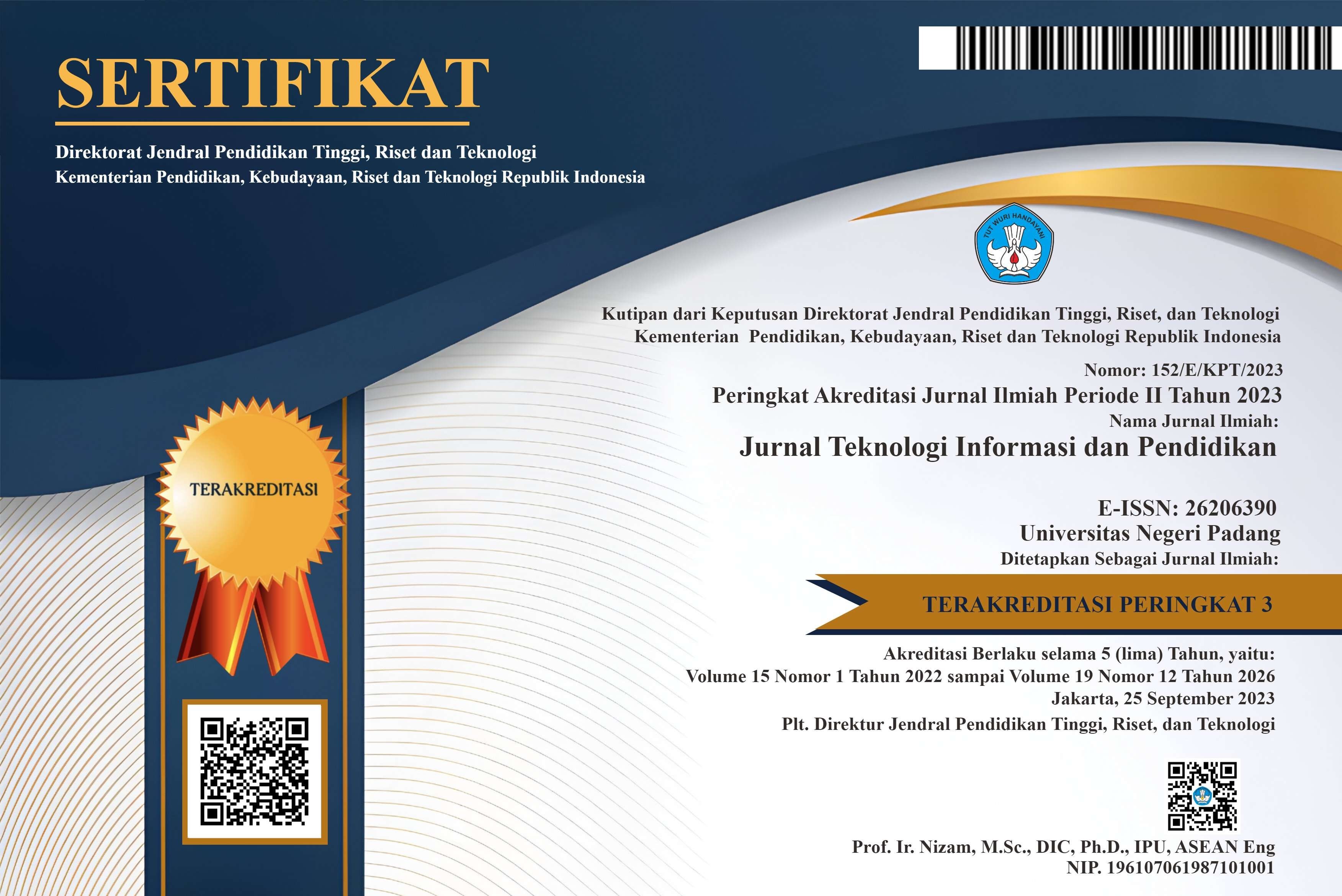LoRa and IoT-based Heart Rate and Temperature Monitoring Tool Using MQTT Protocol
DOI:
https://doi.org/10.24036/jtip.v16i1.769Keywords:
▪ Monitoring ▪ Long Range (LoRa) ▪ Internet of Things (IoT) ▪ MQTT Protocol ▪ Heart Rate ▪ TemperatureAbstract
Heart rate is one of the most important organs in the human body as it plays a role in the circulatory system. Body temperature is the result of the body's metabolic processes and is influenced by external and internal factors. In this research, we design a monitoring tool that uses LoRa and IoT technology to monitor heart rate and human body temperature. This tool aims to provide real-time health monitoring and can communicate remotely. MQTT allows efficient data transmission between connected devices in the network. Pulse heart rate sensor and temperature sensor MLX90614 The data obtained from these two sensors is sent through the LoRa network to the LoRa gateway. The LoRa gateway functions as a link between the monitoring device and the MQTT server. The gateway receives data from the monitoring device via the LoRa network and forwards it to the MQTT server via an internet connection. The MQTT server sends the data to an application that can be accessed via a smartphone. The test results show that the RSSI value of -72.5 dBm is obtained when the minimum distance is 5 metres. The lowest value for RSSI, which is -93.5 dBm, is obtained at the maximum testing distance of about 55 metres. For the results of the packet loss value is 0% occurs at a closer distance, but at a distance of 50m (5%) and at a distance of 55m (20%) indicates that the signal begins to weaken or experience interference at a greater distance
References
[2] D. Salsabila, A. T. Hanuranto, and A. Irawan, “Sistem monitoring denyut jantung berbasis IoT menggunakan protokol XMPP,” JITEL (Jurnal Ilm. Telekomun. Elektron. dan List. Tenaga), vol. 2, no. 2, pp. 171–178, 2022, doi: 10.35313/jitel.v2.i2.2022.171-178.
[3] S. Sollu, A. Alamsyah, and M. Bachtiar, “Sistem Pemantauan Sinyal Detak Jantung Pasien Menggunakan Protokol Zigbee Dan Arduino,” Techno.Com, vol. 16, no. 4, pp. 411–420, 2017, doi: 10.33633/tc.v16i4.1528.
[4] D. Sutarya, P. Studi, T. Elektro, F. Teknik, U. Budi, and J. Selatan, “Sistem Monitoring Kadar Gula Darah , Kolestrol dan Asam Urat secara Non Invasive menggunakan Sensor,” J. joule J. Ilm. Teknol. Energi, Teknol. Media Komun. dan Instrumentasi Kendali, vol. 1, no. 1, pp. 25–34, 2021.
[5] P. Karina and A. H. Thohari, “Perancangan Alat Pengukur Detak Jantung Menggunakan Pulse Sensor Berbasis Raspberry,” J. Appl. Informatics Comput., vol. 2, no. 2, pp. 57–61, 2018, doi: 10.30871/jaic.v2i2.920.
[6] F. Hakim and H. Nurwarsito, “Sistem Pemantauan Detak Jantung dan Suhu Tubuh menggunakan Protokol Komunikasi MQTT,” J. Pengemb. Teknol. Inf. dan Ilmu Komput., vol. 3, no. 11, pp. 10705–10711, 2019.
[7] A. T. Parawangsa et al., “Jaringan WBN Multisensor untuk Aplikasi Monitoring Kesehatan Pasien,” pp. 2–6.
[8] A. F. Arrafi, S. Hadiyoso, and R. Mayasari, “Implementasi Dan Analisis Jaringan Sensor Nirkabel Untuk Monitoring Suhu Tubuh Dengan Algoritma Cluster-Tree Implementation and Analysis of Wireless Sensor Network for Body Temperature Monitoring With Cluster-Tree Algoritm,” vol. 2015, no. September, pp. 5–6, 2015.
[9] A. Zakaria, M. Subito, and A. Amir, “Sistem Monitoring Tekanan Darah Berbasis Wireless,” Techno.Com, vol. 18, no. 4, pp. 312–320, 2019, doi: 10.33633/tc.v18i4.2553.
[10] G. A. Ho, M. Fajar, A. Munir, M. D. Jantung, and S. Pulse, “Desain sistem pemantau kesehatan pasien berbasis jaringan sensor nirkabel,” vol. 9, no. 1, pp. 113–123, 2022.
[11] N. Dyanningrum, D. Zulherman, and H. Pujiharsono, “Analisis Rancangan Sistem Pengukuran Denyut Nadi Berbasis Internet of Things,” Proc. Conf. Electr. Eng., vol. 1, no. 2, pp. 13–18, 2018.
[12] F. Akbar, R. Maulana, and H. Fitriyah, “Sistem Monitoring Denyut Jantung Menggunakan NodeMCU Dan MQTT,” J. Pengemb. Teknol. Inf. dan Ilmu Komput. Univ. Brawijaya, vol. 2, no. 12, pp. 5969–5976, 2018, [Online]. Available: https://j-ptiik.ub.ac.id/index.php/j-ptiik/article/view/3480/1366.
[13] R. P. Astutik and R. F. Bakti, “SISTEM MONITORING DETAK JANTUNG BERBASIS LoRa,” E-Link J. Tek. Elektro dan Inform., vol. 15, no. 1, p. 19, 2020, doi: 10.30587/e-link.v15i1.1606.
[14] I. Salamah, S. N. Afifa, and E. Hesti, “Rancang Bangun Pendeteksi Penyakit Jantung menggunakan Teknik Algoritma Fuzzy Logic berbasis IoT,” Edumatic J. Pendidik. Inform., vol. 6, no. 2, pp. 176–185, 2022, doi: 10.29408/edumatic.v6i2.6164.
[15] D. Surya Putra, N. A. Bogi, and R. Mayasari, “Rancang Bangun Smart Lighting Dan Monitoring Kondisi LampuJalan Berbasis Wireless Sensor Network Menggunakan Lora,” e-Proceeding Eng., vol. 6, no. 2, p. 4748, 2019.
[16] B. A. S. E. Sitorus, R. Setiawan, and N. F. Hikmah, “Multi-Parameter Monitoring Menggunakan Jaringan Sensor Wireless untuk Aplikasi Monitoring dan Database Medis,” J. Tek. ITS, vol. 9, no. 1, pp. 92–97, 2020, doi: 10.12962/j23373539.v9i1.50922.
[17] Y. Mukhammad and A. S. Hyperastuty, “Sensitivitas Sensor MLX90614 Sebagai Alat Pengukur Suhu Tubuh Tubuh Non-Contact Pada Manusia,” Indones. J. Prof. Nurs., vol. 1, no. 2, p. 51, 2021, doi: 10.30587/ijpn.v1i2.2339.
[18] I. Yulia Basri, D. Novaliandry, and I. Maisa Tania, “Design and Development of Inductive Sensor Trainer Based on Arduino and IDE 1.8.19 Software,” J. Teknol. Inf. dan Pendidik.,vol.15,no. 1, 2022, [Online]. Available:
https://doi.org/10.24036/tip.v15i1.
[19] H. Isyanto and I. Jaenudin, “Monitoring Dua Parameter Data Medik Pasien (Suhu Tubuh Dan Detak Jantung) Berbasis Aruino Nirkabel,” eLEKTUM, vol. 15, no. 1, pp. 19–24,2018,[Online].Available: https://jurnal.umj.ac.id/index.php/elektum/article/view/2114.















.png)














